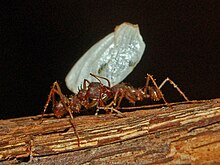Fungus-growing ants
| Attini | |
|---|---|

| |
| Atta mexicana workers carrying a leaf section | |
| Scientific classification | |
| Domain: | Eukaryota |
| Kingdom: | Animalia |
| Phylum: | Arthropoda |
| Class: | Insecta |
| Order: | Hymenoptera |
| Family: | Formicidae |
| Subfamily: | Myrmicinae |
| Tribe: | Attini Smith, 1858 |
| Type genus | |
| Atta Fabricius, 1804
| |
| Genera | |
|
See text | |
| Diversity[1] | |
| 46 genera | |
Fungus-growing ants (tribe Attini) comprise all the known fungus-growing ant species participating in ant-fungus mutualism. They are the sister group to the subtribe Dacetina.[2] Leafcutter ants, including Atta and Acromyrmex, make up two of the genera.[3] Their cultivars come from the fungal tribe Leucocoprineae[2] of family Agaricaceae.
This New World ant clade is thought to have originated about 60 million years ago in the South American rainforest.[2] While the fungal cultivars of the 'lower' attine ants can survive outside an ant colony, those of 'higher' attine ants are obligate mutualists. This obligate mutualism is thought to have evolved outside the rainforest, in areas where the fungi would not have been able to survive outside a colony anyway due to the dry environment.[2]
Genera
- Acanthognathus Mayr, 1887
- Acromyrmex Mayr, 1865
- Allomerus Mayr, 1878
- Apterostigma Mayr, 1865
- Atta Fabricius, 1804
- †Attaichnus Laza, 1982
- Basiceros Schulz, 1906
- Blepharidatta Wheeler, 1915
- Cephalotes Latreille, 1802
- Chimaeridris Wilson, 1989
- Colobostruma Wheeler, 1927
- Cyatta Sosa-Calvo et al., 2013
- Cyphomyrmex Mayr, 1862
- Daceton Perty, 1833
- Diaphoromyrma Fernández, Delabie & Nascimento, 2009
- Epopostruma Forel, 1895
- Eurhopalothrix Brown & Kempf, 1961
- Ishakidris Bolton, 1984
- Kalathomyrmex Klingenberg & Brandão, 2009
- Lachnomyrmex Wheeler, 1910
- Lenomyrmex Fernández & Palacio, 1999
- Mesostruma Brown, 1948
- Microdaceton Santschi, 1913
- Mycetagroicus Brandão & Mayhé-Nunes, 2001
- Mycetarotes Emery, 1913
- Mycetophylax Emery, 1913
- Mycetosoritis Wheeler, 1907
- Mycocepurus Forel, 1893
- Myrmicocrypta Smith, 1860
- Ochetomyrmex Mayr, 1878
- Octostruma Forel, 1912
- Orectognathus Smith, 1853
- Paramycetophylax Kusnezov, 1956
- Phalacromyrmex Kempf, 1960
- Pheidole Westwood, 1839
- Pilotrochus Brown, 1978
- Procryptocerus Emery, 1887
- Protalaridris Brown, 1980
- Pseudoatta Gallardo, 1916
- Rhopalothrix Mayr, 1870
- Sericomyrmex Mayr, 1865
- Strumigenys Smith, 1860
- Talaridris Weber, 1941
- Trachymyrmex Forel, 1893
- Tranopelta Mayr, 1866
- Wasmannia Forel, 1893
See also
References
- ^ Bolton, B. (2015). "Attini". AntCat. Retrieved 18 August 2015.
- ^ a b c d Branstetter, M. G.; Ješovnik, A.; Sosa-Calvo, J.; Lloyd, M. W.; Faircloth, B. C.; Brady, S. G.; Schultz, T. R. (2017-04-12). "Dry habitats were crucibles of domestication in the evolution of agriculture in ants" (PDF). Proceedings of the Royal Society B: Biological Sciences. 284 (1852): 20170095. doi:10.1098/rspb.2017.0095.
- ^ Weber, N.A. (1966). "Fungus-Growing Ants". Science. 153 (3736): 587–604. doi:10.1126/science.153.3736.587.
External links
 Media related to Attini at Wikimedia Commons
Media related to Attini at Wikimedia Commons
